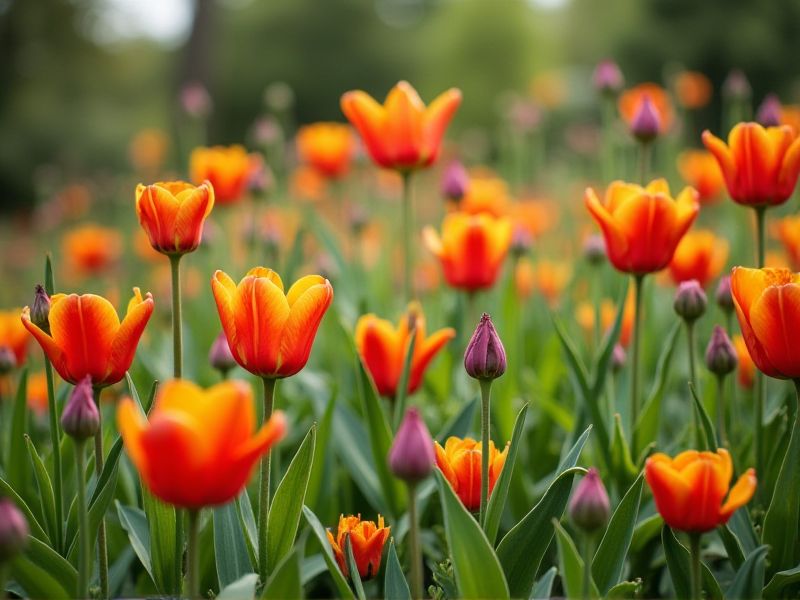
Heat-tolerant annual plants thrive in warm, arid conditions, making them ideal for summer gardens. Varieties such as zinnias, marigolds, and cosmos exhibit vibrant blooms and require minimal water, perfect for drought-prone areas. The resilient portulaca, or moss rose, features succulent leaves that retain moisture, ensuring long-lasting flowering in extreme temperatures. Incorporating heat-resistant herbs like basil and oregano not only enhances your culinary dishes but also adds greenery to your garden. Choose these plants to create a colorful, low-maintenance landscape that flourishes under the sun.
List of some Annual plants that withstand heat
- Zinnia (Zinnia elegans)
- Marigold (Tagetes tenufolia)
- Cosmos (Cosmos bipinnatus)
- Portulaca (Portulaca grandiflora)
- Sunflower (Helianthus annuus)
- Celosia (Celosia argentea)
- Gomphrena (Gomphrena globosa)
- Vinca (Catharanthus roseus)
- Lantana (Lantana camara)
- Nasturtium (Tropaeolum majus)
Important things about Annual plants that withstand heat
Heat Tolerance Varieties
Heat-tolerant annual plants are essential for thriving gardens in warmer climates. Varieties like zinnias, marigolds, and sunflowers have been selectively bred to endure high temperatures and drought conditions. These resilient plants not only enhance your garden's aesthetic appeal but also attract beneficial pollinators, promoting biodiversity. Incorporating these heat-resistant annuals into your landscape will ensure vibrant blooms even during the hottest months.
Drought Resistance
Annual plants such as amaranth, sorghum, and cowpea are exemplary choices for drought resistance, showcasing exceptional adaptability to heat and limited water availability. These plants have developed unique physiological traits, including deep root systems and waxy leaves, which help them conserve moisture and reduce transpiration. By incorporating these heat-tolerant annuals into your garden or agricultural practices, you can maintain productivity even during periods of water scarcity. Understanding their growth cycles and stress responses can optimize your cultivation strategies and enhance sustainability in changing climates.
Appropriate Planting Time
For annual plants that withstand heat, the optimal planting time is essential for their robust development. Generally, late spring to early summer is the ideal window, as these warm-weather crops thrive in temperatures between 70degF and 90degF. You should consider drought-resistant varieties like marigolds, zinnias, and portulaca, which not only tolerate high temperatures but also require less water. Planting during this period ensures that your annuals establish strong roots before the peak heat of summer arrives.
Soil Quality And Drainage
Annual plants that tolerate heat typically thrive in well-draining soil, which is critical for preventing root rot and promoting healthy growth. Soil quality plays a vital role in moisture retention and nutrient availability, so it's important to amend your soil with organic matter to improve drainage and enhance fertility. Varieties such as zinnias, marigolds, and certain legumes excel in hot climates and can be cultivated in sandy or loamy soils that drain efficiently. By focusing on optimal soil conditions, you can ensure that your heat-resistant annuals flourish even in challenging environments.
Watering Techniques
When cultivating annual plants that endure heat, employing efficient watering techniques is crucial for their survival and growth. Drip irrigation systems can deliver water directly to the plant's root zone, minimizing evaporation and ensuring that the moisture reaches where it is most needed. Mulching around your plants helps retain soil moisture while regulating temperature, creating an optimal environment for heat-resistant varieties. It's important to water early in the morning or late in the evening to prevent rapid evaporation and to encourage deep root development in these resilient annuals.
Mulching Benefits
Mulching is essential for annual plants that withstand heat, as it helps retain soil moisture and regulate temperature. By using organic mulch, such as straw or shredded leaves, you can reduce soil evaporation while providing nutrients as it breaks down. This protective layer not only reduces weed growth but also enhances soil structure, creating an optimal environment for heat-tolerant varieties like sunflowers and zinnias. Implementing mulch in your garden can significantly improve the resilience and health of your annual plants during hot weather.
Fertilization Needs
Annual plants that withstand heat, such as zinnias, cosmos, and marigolds, are ideal for gardeners in warmer climates. These resilient species not only bloom vibrantly but also demonstrate drought resistance, making them suitable for low-water gardens. You can enhance their growth by applying a balanced fertilizer, rich in nitrogen, phosphorus, and potassium, ensuring optimal blooming and root development. Choosing heat-tolerant annuals can create stunning landscapes while conserving water and resources throughout the summer months.
Pest And Disease Resilience
Annual plants such as sunflowers, zinnias, and certain varieties of millet exhibit remarkable resilience to heat and pests, making them ideal for summer gardens. These plants have adapted to high temperatures and dry conditions by developing deep root systems and thick cuticles that reduce water loss. Incorporating pest-resistant cultivars, like heat-tolerant tomatoes or peppers, can enhance your garden's productivity while minimizing reliance on chemical treatments. By selecting these robust annual plants, you create a vibrant and sustainable garden space that thrives even in challenging climatic conditions.
Sunlight Requirements
Annual plants that withstand heat thrive in full sun, demanding at least six to eight hours of direct sunlight daily. These resilient species, such as marigolds, zinnias, and sunflowers, not only enhance your garden's aesthetic appeal but also contribute to local biodiversity by attracting pollinators. When selecting heat-tolerant annuals, consider the soil's drainage and nutrient content, which significantly influence their growth and vigor under intense sunlight. Properly spaced plants ensure adequate air circulation, reducing the risk of heat stress and fostering robust development throughout the growing season.
Harvest Timing
Choosing the right harvest timing for annual plants that withstand heat is crucial for maximizing yield and quality. Heat-tolerant varieties, such as okra, black-eyed peas, and zinnias, should be harvested in the early morning or late afternoon to minimize stress from high temperatures. Monitoring the moisture content and size of the fruit or vegetable is essential, as many heat-resistant plants mature rapidly under intense sunlight. You can enhance your harvest by regularly checking for signs of ripeness, ensuring that you collect produce at its peak freshness before it succumbs to sun damage.
